An enigmatic variable star "resurfaces" after 11 years, while Pluto takes part in an occultation that'll be widely visible across the U.S.. Mexico and Central America.
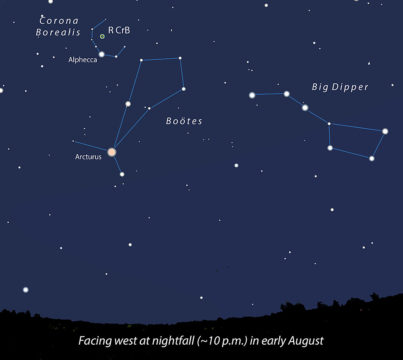
Stellarium
Anyone interested in astronomy soon becomes attuned to the cycles of celestial objects — the daily rise and set of the Sun, the 333-day pulsation of the variable star Mira, and even the 84-year-long creep of Uranus around the zodiac.
These cycles are predictable — but the ups and downs of the variable star R Coronae Borealis are not. Its changeability was first discovered in 1795 by English astronomer Edward Pigott. I’ve kept my eye on this peculiar star since 1982. When at maximum light, it's a hair brighter than the nominal naked-eye limit of magnitude 6 and faintly visible with averted vision in the horseshoe-shaped constellation Corona Borealis.
R CrB burns with a steady light for years at a time as it did from 2003 to 2007. I'd glance up every clear night from spring through fall and could always count on it being there, however faintly. But on July 6, 2007, I noticed it was more difficult to acquire. Within days, the star had departed the naked-eye realm, fading a magnitude a week until six months later I needed a 10-inch telescope to scare it up.
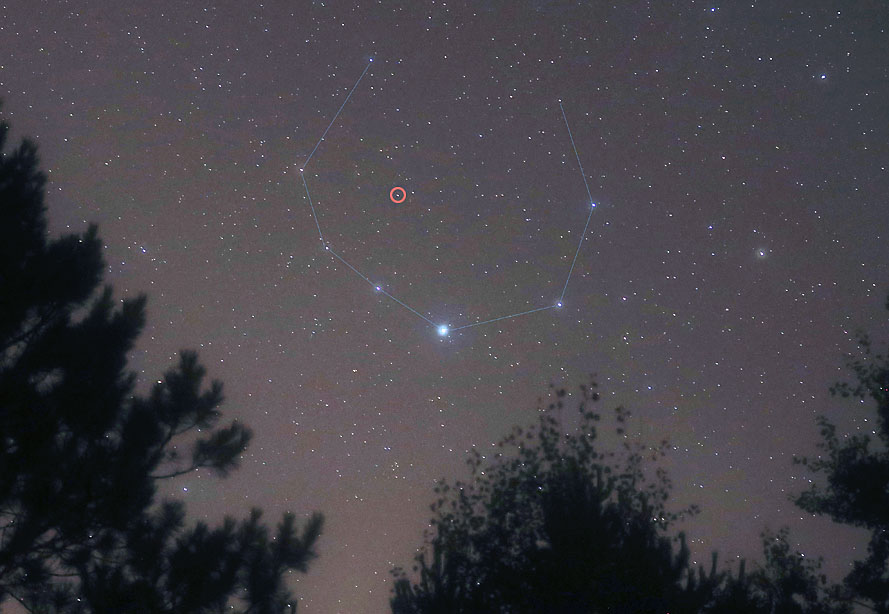
Bob King
Once R CrB bottomed out at 15th magnitude in early 2009 it went into hiding for almost two years. Would the star ever recover, I wondered? Starting in late 2010 through early 2011, R ticked upward by several magnitudes only to plummet again. After more ups and downs the star finally began a steady climb in brightness in the spring of 2016 and now shines at magnitude 6.4 (as of August 7th, 12:00 UT). Finally, I can — with effort — glance upward and see it dimly without optical aid. I'm happy to see its return and wanted to share the news in case its escapades have escaped your attention. If you haven't been following R, start now so you can watch its fascinating and unpredictable swings for years to come.
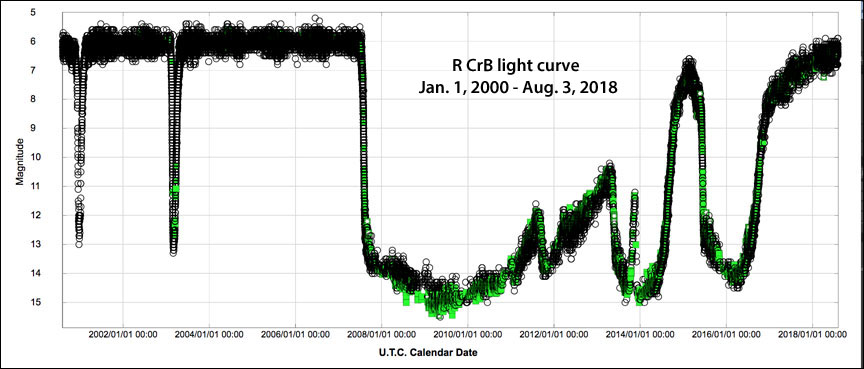
AAVSO
R CrB is the prototype of a class of stars called R Coronae Borealis variables that fade away at random intervals only to return to full light weeks, months, or even years later. Most are yellow supergiants 10,000 times as bright as the Sun that have lost their outer envelope of hydrogen gas, exposing a helium- and carbon-rich atmosphere.
Hot and massive, these stars expel powerful winds of helium and carbon atoms into space at 100,000 times the rate of the solar wind. A small percentage of that carbon condenses into discrete “puffs” of soot. If one of these carbon dust clouds happens to move into our line of sight, it blocks the light of the star, causing it to dim. Only when the cloud has expanded and thinned — or is blown away by continued winds — does the star return to its normal brightness. Other models suggest that the carbon may form in the photosphere (that is, the visible surface) of R CrB stars. Either way, carbon is the culprit.
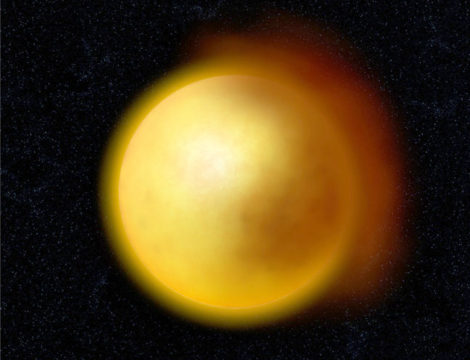
ESO
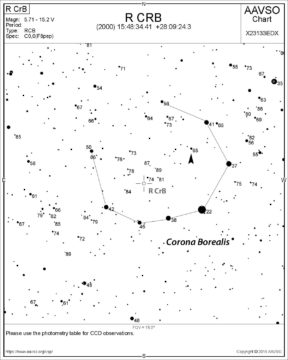
AAVSO
Nobody knows exactly what triggers R CrB’s sooty outbursts, but every few years it belches out another cloud and goes into hiding again. This latest dimming saw the star reach an historical low; it’s also been the longest fade-out on record. Although its climb back to the top seems assured, you never know. A week from now it could be headed back to obscurity. That's why it's fun and informative to keep an eye on its fluctuations.
Another R CrB star to watch, especially if you're a southern observer, is RY Sagittarii, located a few degrees southeast of the Milk Dipper asterism in Sagittarius. The star typically varies between magnitude 6 and 7, making it a great binocular variable. RY Sgr has held to that range since its last deep dip to a magnitude of about 12.5 in early 2008. Add it to your list of must-see, stellar changelings — it could fade away at any time. Track it with this chart.
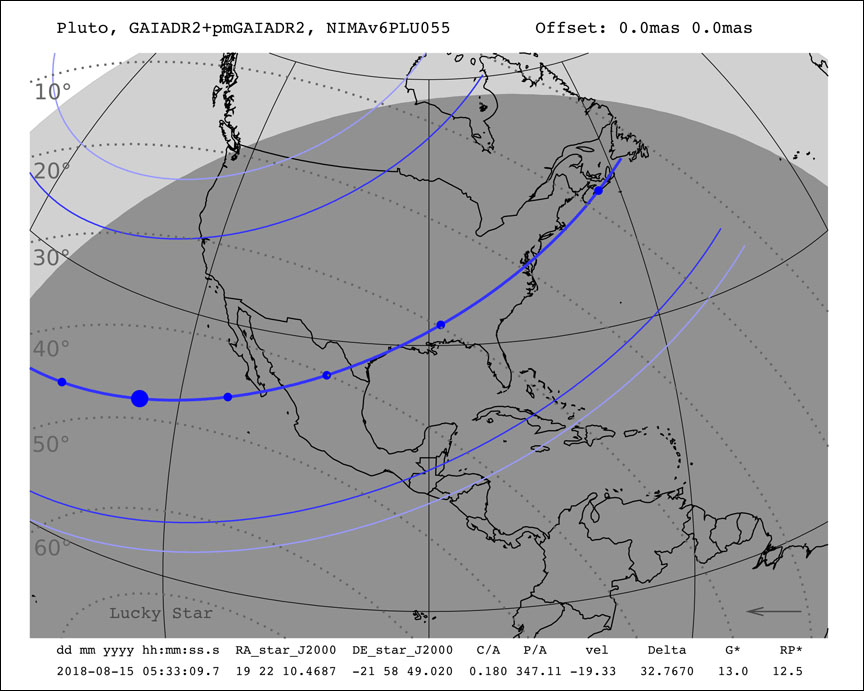
ERC Project Lucky Star
Pluto to Block a Star
While we're on the topic of disappearances, Pluto will occult a 12.9-magnitude star on August 15 at 05:33 UT. For those on and near the centerline, which passes over Nova Scotia, Cape Cod and within spitting distance of New York City, Philadelphia, New Orleans, Houston and Monterrey (Mexico), the star will fade by nearly 1.5 magnitudes for a maximum of 126 seconds. Even if you live as far as North Dakota or southern Mexico, where the occultation will be partial, the star will fade by 50 percent or three-quarters of a magnitude and still show obvious dimming.
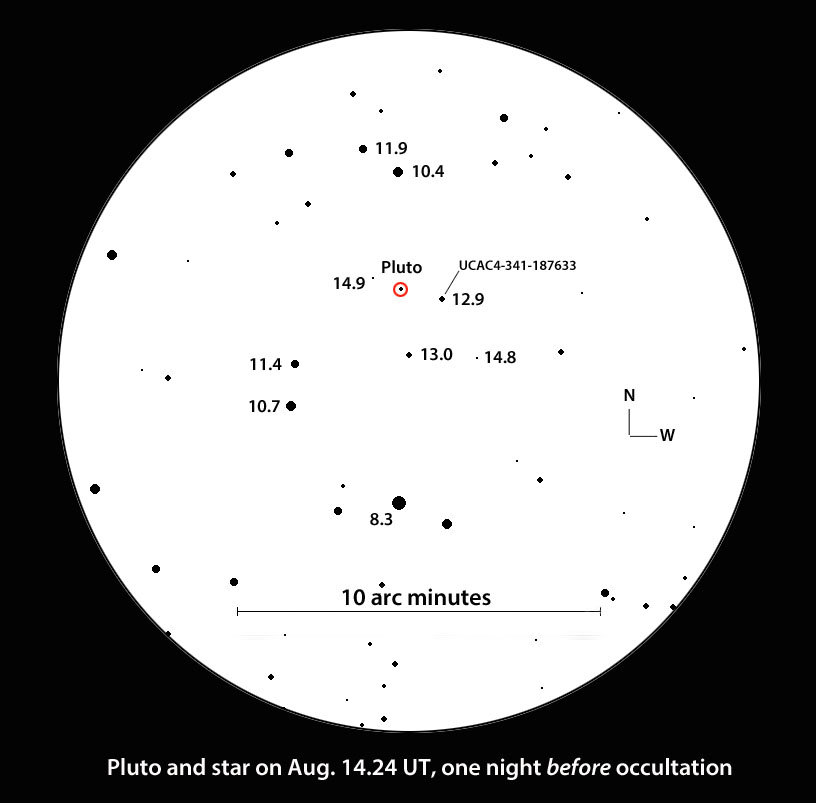
SkyMap with additions by the author
One day before the event, Pluto will lie 1 arcminute to the east of the star and 1 arcminute to the west a day after. I plan to track down the dwarf planet and get familiar with the field the night before, then start early on the night of the occultation and watch Pluto work into a tight "double star" with the occultee before the big moment. Fortunately for U.S. and Mexican observers, Pluto is well-placed for viewing, transiting the meridian around 11 p.m. local time.
If you haven't seen Pluto this summer, the occultation makes for a great opportunity. For more details including how to participate in the observing campaign, head over to the Lucky Star Project's Pluto event page. Careful timings and accurate magnitude estimates as the dwarf planet covers and uncovers the star could yield valuable information about its atmosphere three years after the New Horizons flyby.
To find Pluto, currently at magnitude 14.2, click here for all the maps you'll need. Dates and times are shown in Universal Time (UT). To convert UT to any time zone, click here. For guaranteed clear skies, click ... oh, how I wish!
 3
3









Comments
agarciamorenoe
August 10, 2018 at 7:39 pm
The Pluto occultation centerline is not going across Central America. Only across the US and Mexico.
You must be logged in to post a comment.
Bob KingPost Author
August 10, 2018 at 7:58 pm
Dear Agarcia,
Sorry, my mistake. I saw Mexico and thought Central America. Thank you very much for pointing that out. Now corrected 🙂
You must be logged in to post a comment.
Donald Bruns
August 15, 2018 at 3:36 pm
Success with Pluto in San Diego last night, just as clouds rolled in. Fun experiment, my first of this kind.
You must be logged in to post a comment.
You must be logged in to post a comment.